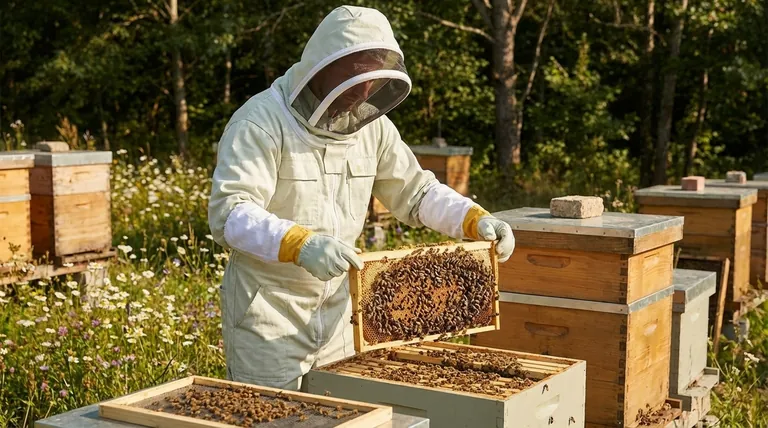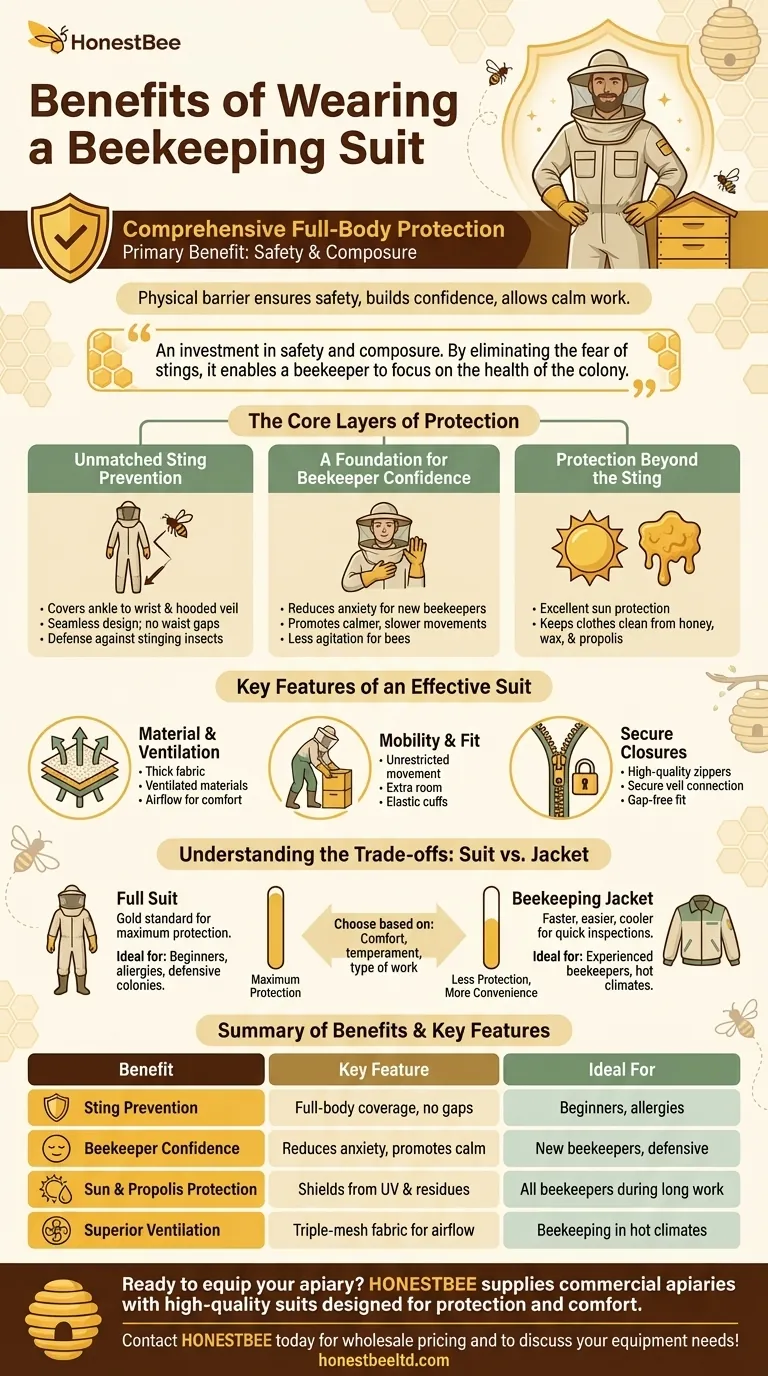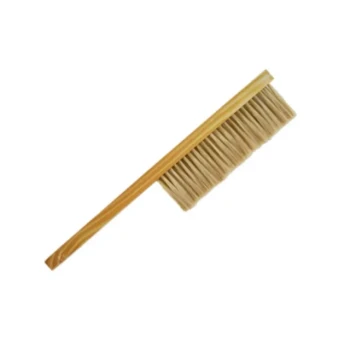The primary benefit of a beekeeping suit is to provide comprehensive, full-body protection from bee stings. This physical barrier not only ensures safety but also builds the beekeeper's confidence, allowing them to work calmly and effectively with their hives.
A beekeeping suit is fundamentally an investment in safety and composure. By eliminating the fear of stings, it enables a beekeeper—especially a novice—to focus on the health of the colony and perform inspections with deliberate, gentle movements.

The Core Layers of Protection
A beekeeping suit offers more than just a simple barrier. Its design addresses the specific physical and psychological challenges of working closely with thousands of stinging insects.
Unmatched Sting Prevention
A full suit covers you from ankle to wrist, with an integrated hooded veil to protect your head and face.
This seamless design leaves no gaps at the waist, a common entry point for bees when a beekeeper is wearing a separate jacket and pants.
It also provides a reliable defense against other stinging insects that may be present near the apiary.
A Foundation for Beekeeper Confidence
For new beekeepers, the fear of being stung can be a significant obstacle. Feeling secure inside a suit helps manage this anxiety.
This confidence translates into calmer, slower movements, which is less likely to agitate the bees and provoke a defensive response.
Protection Beyond the Sting
Working in an apiary often involves exposure to direct sunlight for extended periods. A suit provides excellent sun protection.
It also keeps your regular clothes clean from honey, wax, and especially propolis, a sticky resin bees produce that can be difficult to remove from fabric.
Key Features of an Effective Suit
Not all suits are created equal. The difference between a high-quality suit and a poor one lies in the balance of protection, comfort, and mobility.
Material and Ventilation
The fabric must be thick enough to prevent a bee's stinger from reaching your skin.
Modern suits often feature ventilated materials or triple-mesh constructions, which provide essential airflow and make working in hot weather far more comfortable.
Mobility and Fit
A good suit must not restrict your movement. You need to bend, lift heavy boxes, and reach without the fabric pulling tight.
Look for suits designed with extra room in the shoulders and crotch. Features like elastic cuffs at the wrists and ankles ensure a secure fit that bees cannot crawl through.
Secure Closures
High-quality, durable zippers are critical for sealing the suit properly. The connection between the suit and the veil is a particularly important area to check for a secure, gap-free fit.
Understanding the Trade-offs: Suit vs. Jacket
While a full suit offers the most protection, it is not the only option. Many beekeepers also use beekeeping jackets.
The Case for the Full Suit
The full suit is the gold standard for maximum protection. It is the recommended choice for beginners, anyone with a known bee allergy, or beekeepers working with more defensive or aggressive colonies.
The Practicality of a Beekeeping Jacket
A beekeeping jacket is much faster and easier to put on and take off. It's less cumbersome and often cooler than a full suit.
Many experienced beekeepers prefer a jacket for quick, routine hive inspections, especially in hot climates. However, this convenience comes at the cost of less protection, as it leaves the lower body exposed and creates a potential entry point for bees at the waist.
Making the Right Choice for Your Goal
Selecting the right protective gear depends entirely on your comfort level, the temperament of your bees, and the type of work you plan to do.
- If your primary focus is maximum safety and peace of mind: A full beekeeping suit is the unequivocal best choice, particularly when you are new to beekeeping.
- If your primary focus is convenience for quick inspections: A high-quality ventilated jacket can be a practical and more comfortable alternative for experienced beekeepers.
- If your primary focus is long-term value: Investing in any durable, well-made protective gear with quality zippers and strong material will provide better comfort and more reliable protection over many seasons.
Ultimately, the right protective gear is the one that allows you to be a calm, confident, and effective caretaker for your bees.
Summary Table:
| Benefit | Key Feature | Ideal For |
|---|---|---|
| Sting Prevention | Full-body coverage, no waist gap | Beginners, those with allergies |
| Beekeeper Confidence | Reduces anxiety, promotes calm movements | New beekeepers, defensive colonies |
| Sun & Propolis Protection | Shields from UV rays and sticky residues | All beekeepers during long inspections |
| Superior Ventilation | Triple-mesh fabric for airflow | Beekeeping in hot climates |
Ready to equip your apiary with durable, professional-grade beekeeping suits?
HONESTBEE supplies commercial apiaries and beekeeping equipment distributors with high-quality suits designed for maximum protection and comfort. Our wholesale-focused operations ensure you get the best value on durable gear that builds beekeeper confidence and safety.
Contact HONESTBEE today for wholesale pricing and to discuss your equipment needs!
Visual Guide

Related Products
- Beekeeping Gloves Goatskin Leather with Long Cotton Sleeve for Beekeepers
- Mesh Ventilated 3 Layer Goatskin Beekeepers Gloves for Beekeeping
- Friendly Bee Mascot Costume Vibrant Engaging Promotional Asset
- Professional Galvanized Hive Strap with Secure Locking Buckle for Beekeeping
- Superhero Bee Mascot Costume Dynamic Professional Brand Champion Costume
People Also Ask
- Why do some experienced beekeepers choose not to wear gloves? For Superior Dexterity & Hive Welfare
- What is the safest way to handle frames in beekeeping? Master Gentle Handling for a Calm Hive
- What are the advantages of goatskin leather gloves for beekeeping? Superior Sting Protection for Your Apiary
- Should beekeepers wear gloves, and why? Essential Protection for Beekeepers
- What is the difference between cleaning cow leather and goat leather beekeeping gloves? Tailor Your Care for Longevity



















